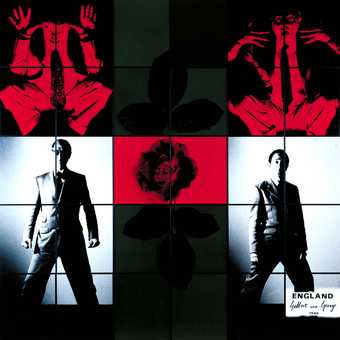
Gilbert & George, England 1980. Tate. © Gilbert and George.
No Such Thing as Society 1980–1990
14 rooms in Modern and Contemporary British Art
Against a backdrop of economic and social transformation, artists in the 1980s explore their experience of the land and the body to reflect on their own identities and sense of belonging
Margaret Thatcher’s premiership spans and defines much of Britain in this decade. Her government cuts public spending, privatises nationalised industries and challenges the power of unions. In 1984, the National Union of Mineworkers holds a year-long strike. By 1986, over three million people are unemployed. Meanwhile, after the ‘Big Bang’ of financial deregulation, the wealth of the City of London’s financial sector increases. The Northern Ireland conflict, known as the Troubles, continues. Young Black people across England clash with law enforcement against racial discrimination and police brutality. In 1986, as the AIDS epidemic rips through LGBTQIA+ communities, the British government prohibits local authorities from promoting, LGBTQIA+ rights.
Many of the artists in this room make work reflecting on life in Britain. Artists reframe their familiar ideas to express a combination of hope and frustration. Britain is viewed from the North of England, suburban gardens, the streets of Brixton in South London, and the Maze Prison in Northern Ireland. Other artists focus on the body to explore the boundaries between private and public social space. Some reflect on the experience of illness and death. Others make work about gender identity, sexuality or racial violence, using their personal experiences of being othered or excluded.
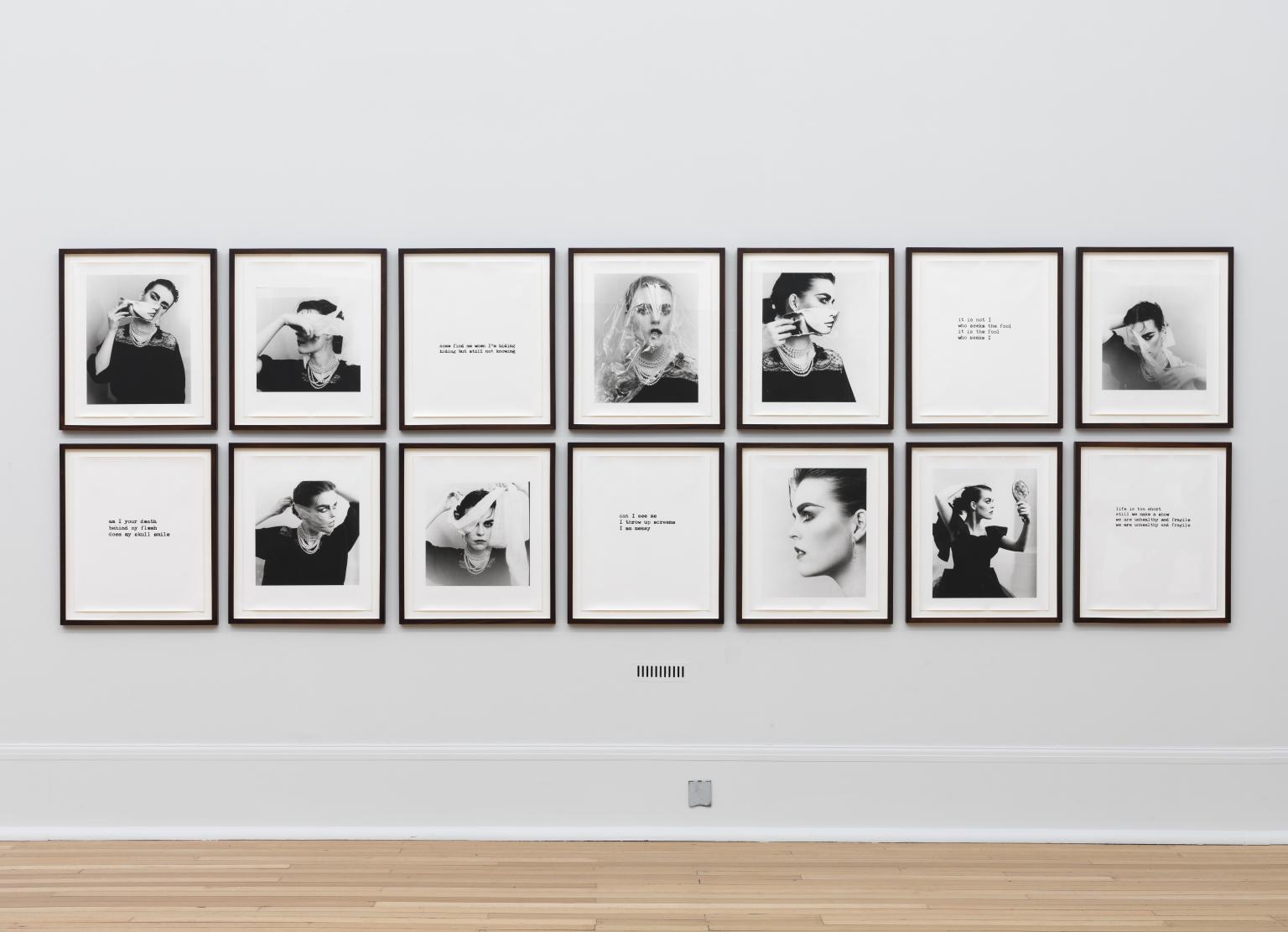
Linder, She/She 1981, printed 2007
She/She consists of fourteen black and white photographs, nine of which are portraits of Linder and the remaining five are photographs of short sections of text written in a typewriter font. The prints are presented in black frames, usually displayed in two horizontal rows of seven to be viewed in the sequence top row left to right, bottom row left to right, with the text pages interspersing the portraits. The photographs of Linder are by the Swiss photographer Christine Birrer, with whom Linder collaborated at this time on a number of different projects. The work was first produced in a booklet Pickpocket: SheShe 1981 to coincide with the release of a six-track cassette tape, Pickpocket, by the group Ludus, of which Linder was a member. The booklet format was slightly different to that originally conceived, and as it has now been printed and editioned. The fragments of text are written by Linder and taken from three of the songs on the cassette, Mutilate, The Fool and Mouthpiece. They refer to the themes of hiding, searching and finding evoked in the images.
1/20
artworks in No Such Thing as Society
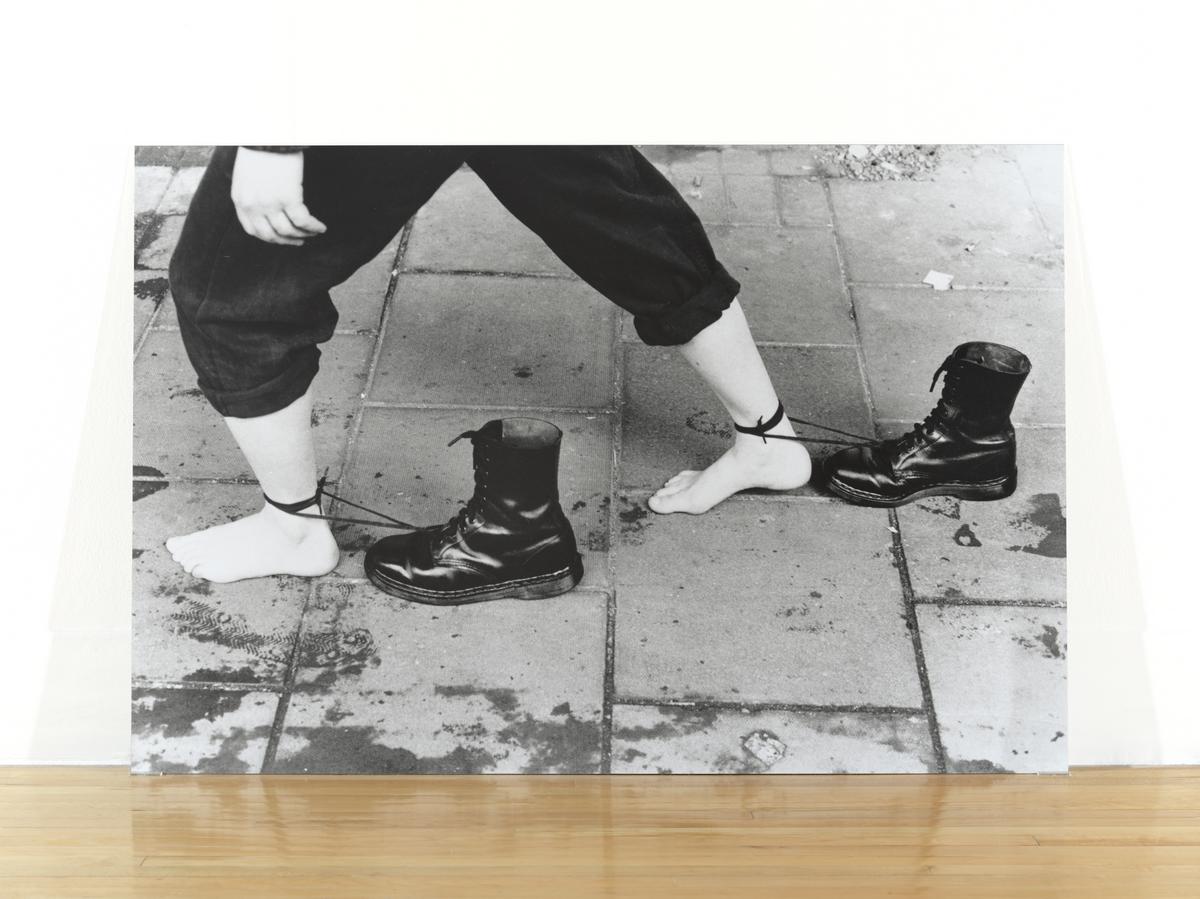
Mona Hatoum, Performance Still 1985–95
Mona Hatoum first became known in the early 1980s for a series of performance and video pieces which used her own body as a site for exploring the fragility and strength of the human condition under duress. Performance Still 1985 records one of three street performances which Hatoum carried out in Brixton for the Roadworks exhibition organised in 1985 by the Brixton Artists Collective. The performance consisted of the artist walking barefoot through the streets of Brixton for nearly an hour, with Doc Marten boots, usually worn by both police and skinheads, attached to her ankles by their laces. Performance Still, printed and published ten years later turns the original documentary photograph of the performance into a work in its own right, and has therefore come to identify this aspect of Hatoum’s practice.
Gallery label, October 2013
2/20
artworks in No Such Thing as Society
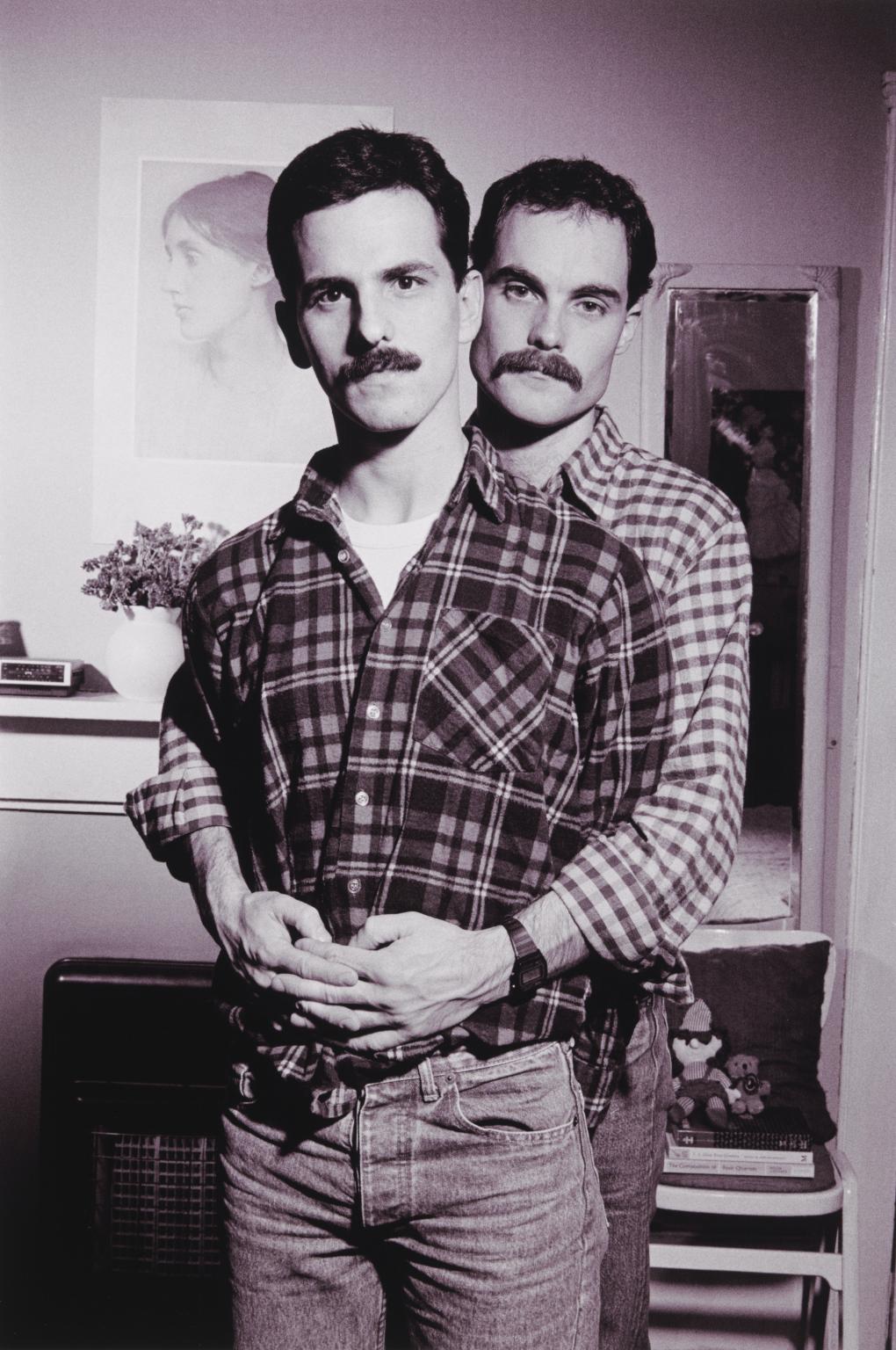
Sunil Gupta, Johnathan & Kim, London 1985, printed 2018
This is one of a group of photographs in Tate’s collection from Sunil Gupta’s Lovers: Ten Years On, a series of over thirty black and white portraits of gay couples taken in the United Kingdom between 1984 and 1986 (Tate P82123–P82137 and Ian and Julian P13784). With the exception of Martin & Gary, Newcastle-upon-Tyne 1984 (Tate P82123), they were all taken in London. Lovers: Ten Years On was made after Gupta’s own ten-year relationship ended and, as a form of social analysis, he decided to document the long-term gay relationships he encountered and the changing sensibilities of the social environment he found himself a part of. Most of the subjects are from his own social milieu at the time, professional couples resident in the Greater London area. Taken over a period of two years, the black and white portraits all follow the same format – they are shot in domestic interiors, the poses and arrangements reminiscent of traditional family photographs. The subjects are centred in the frame and look directly into the camera. Most of the couples are shown in affectionate poses and embraces within their domestic settings; some included their pets in the picture, others chose to be depicted in front of works of art in their living rooms, surrounded by books, or in their kitchens.The series was accompanied by an artist’s statement, in which Gupta observed that while there had been a shift in gay self-consciousness since the 1970s, the arrival of HIV and Aids had once again turned public opinion against the acceptance of homosexuality, and that its popular and commercial representations were dominated by a stereotype of deviance. In contrast, the couples in Lovers: Ten Years On are shown as often quite ordinary, white middle-class, professional people in long term monogamous relationships. Gupta wrote:
3/20
artworks in No Such Thing as Society

Gilbert & George, England 1980
Gilbert and George started their collective practice with performance and went on to make multi-part photographic pieces like this. Here, they seem to show an ambivalent attitude towards national identity as their confrontational poses are juxtaposed with the more playful gargoyle-like crouching figures above a faded Tudor rose in the centre. This work is part of a series of over 100 photo-works collectively titled Modern Fears produced between 1980 and 1981, which focus on the death and decay they saw as permeating the urban environment.
Gallery label, September 2016
4/20
artworks in No Such Thing as Society
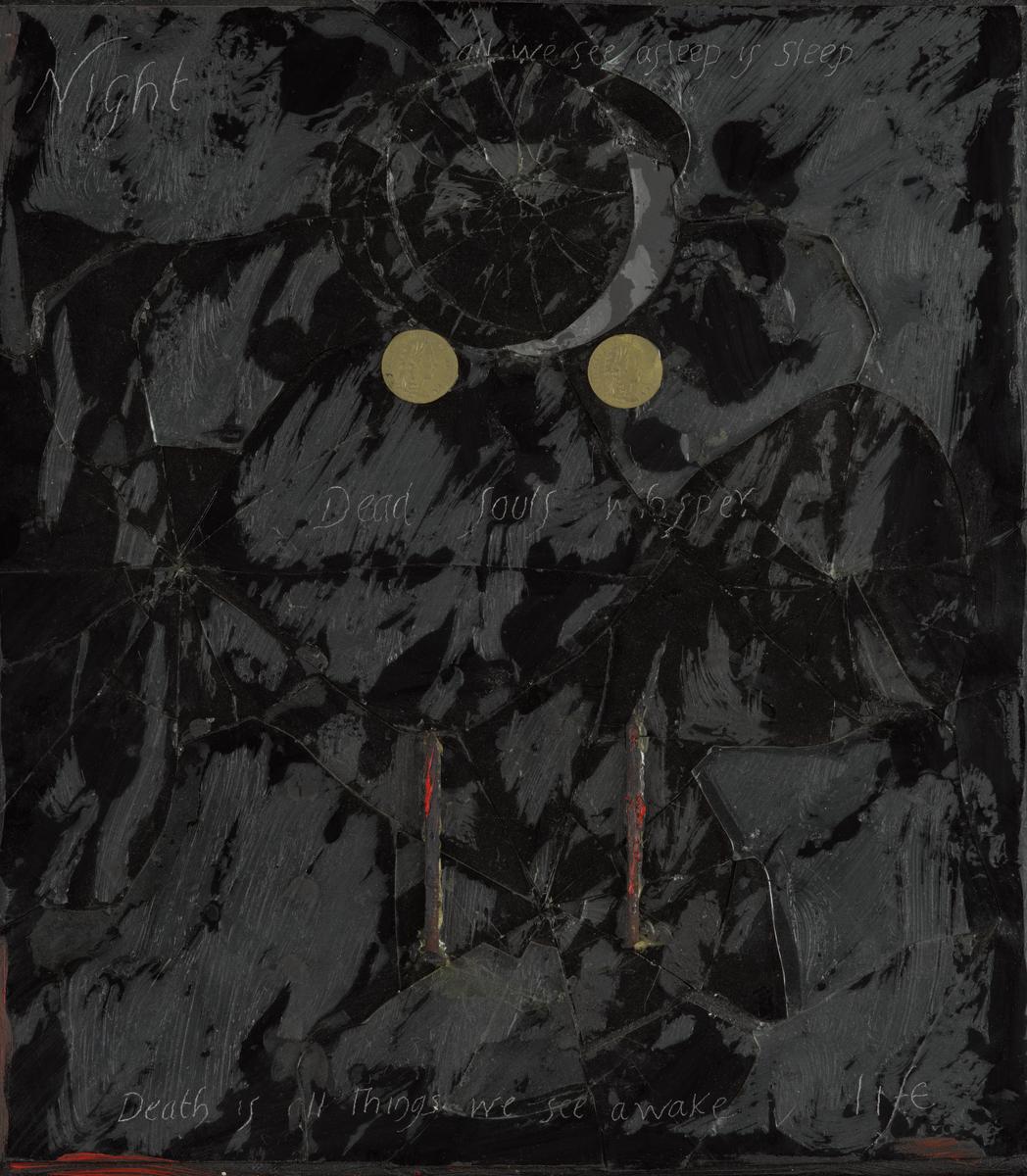
Derek Jarman, Dead Man’s Eyes 1987
5/20
artworks in No Such Thing as Society

Sunil Gupta, Bruno & Daniel, London 1984, printed 2018
This is one of a group of photographs in Tate’s collection from Sunil Gupta’s Lovers: Ten Years On, a series of over thirty black and white portraits of gay couples taken in the United Kingdom between 1984 and 1986 (Tate P82123–P82137 and Ian and Julian P13784). With the exception of Martin & Gary, Newcastle-upon-Tyne 1984 (Tate P82123), they were all taken in London. Lovers: Ten Years On was made after Gupta’s own ten-year relationship ended and, as a form of social analysis, he decided to document the long-term gay relationships he encountered and the changing sensibilities of the social environment he found himself a part of. Most of the subjects are from his own social milieu at the time, professional couples resident in the Greater London area. Taken over a period of two years, the black and white portraits all follow the same format – they are shot in domestic interiors, the poses and arrangements reminiscent of traditional family photographs. The subjects are centred in the frame and look directly into the camera. Most of the couples are shown in affectionate poses and embraces within their domestic settings; some included their pets in the picture, others chose to be depicted in front of works of art in their living rooms, surrounded by books, or in their kitchens.The series was accompanied by an artist’s statement, in which Gupta observed that while there had been a shift in gay self-consciousness since the 1970s, the arrival of HIV and Aids had once again turned public opinion against the acceptance of homosexuality, and that its popular and commercial representations were dominated by a stereotype of deviance. In contrast, the couples in Lovers: Ten Years On are shown as often quite ordinary, white middle-class, professional people in long term monogamous relationships. Gupta wrote:
6/20
artworks in No Such Thing as Society
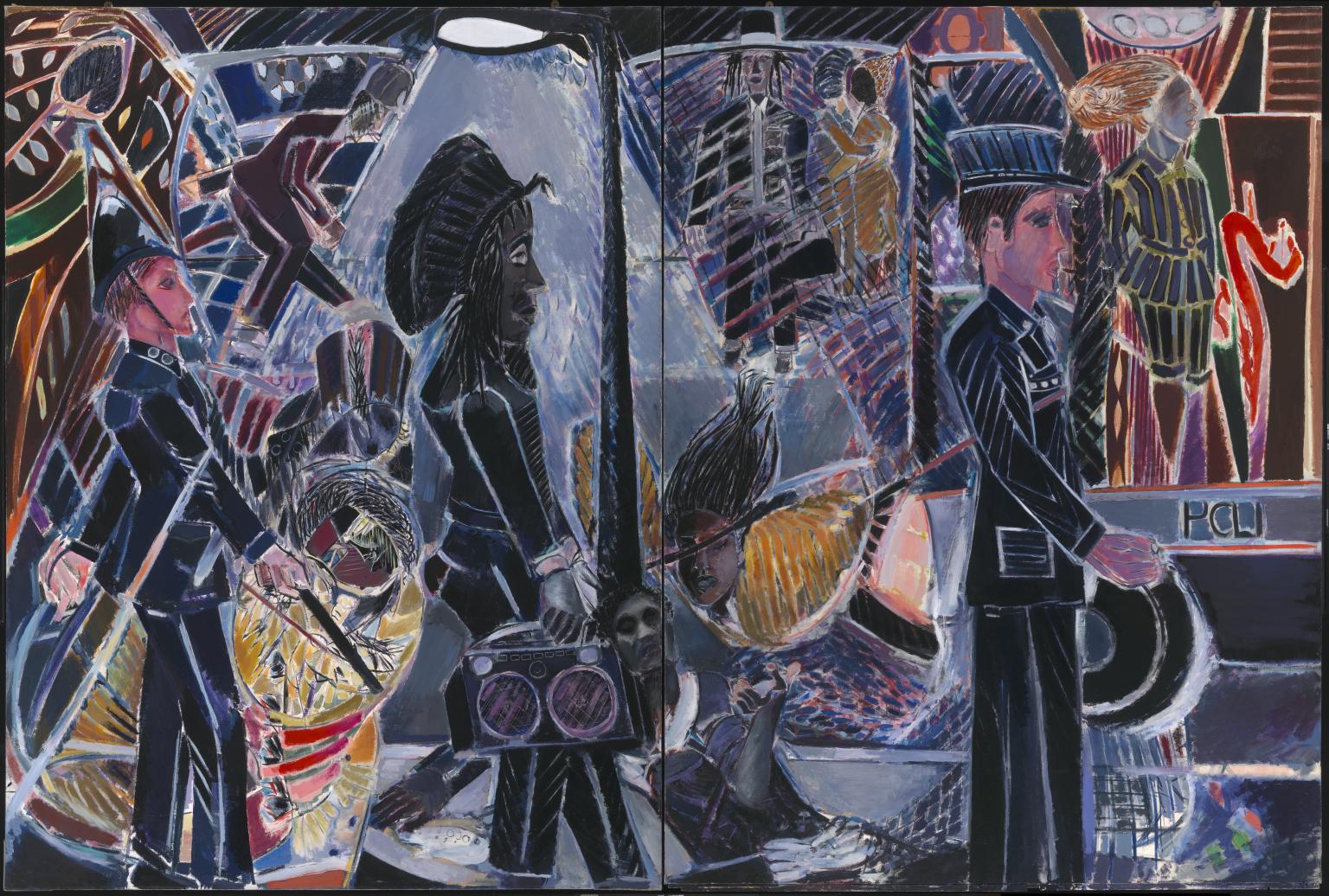
Denzil Forrester MBE, Three Wicked Men 1982
Forrester grew up in Grenada before moving to Britain at the age of ten. Three Wicked Men was made while Forrester was a student at the Royal College of Art. The painting captures the dynamic energy of the London reggae and dub nightclub scene of the early 1980s where Forrester sketched people as they danced. He also portrayed racial and social injustices, prompted by the death in police custody of his friend Winston Rose.
Gallery label, July 2017
7/20
artworks in No Such Thing as Society
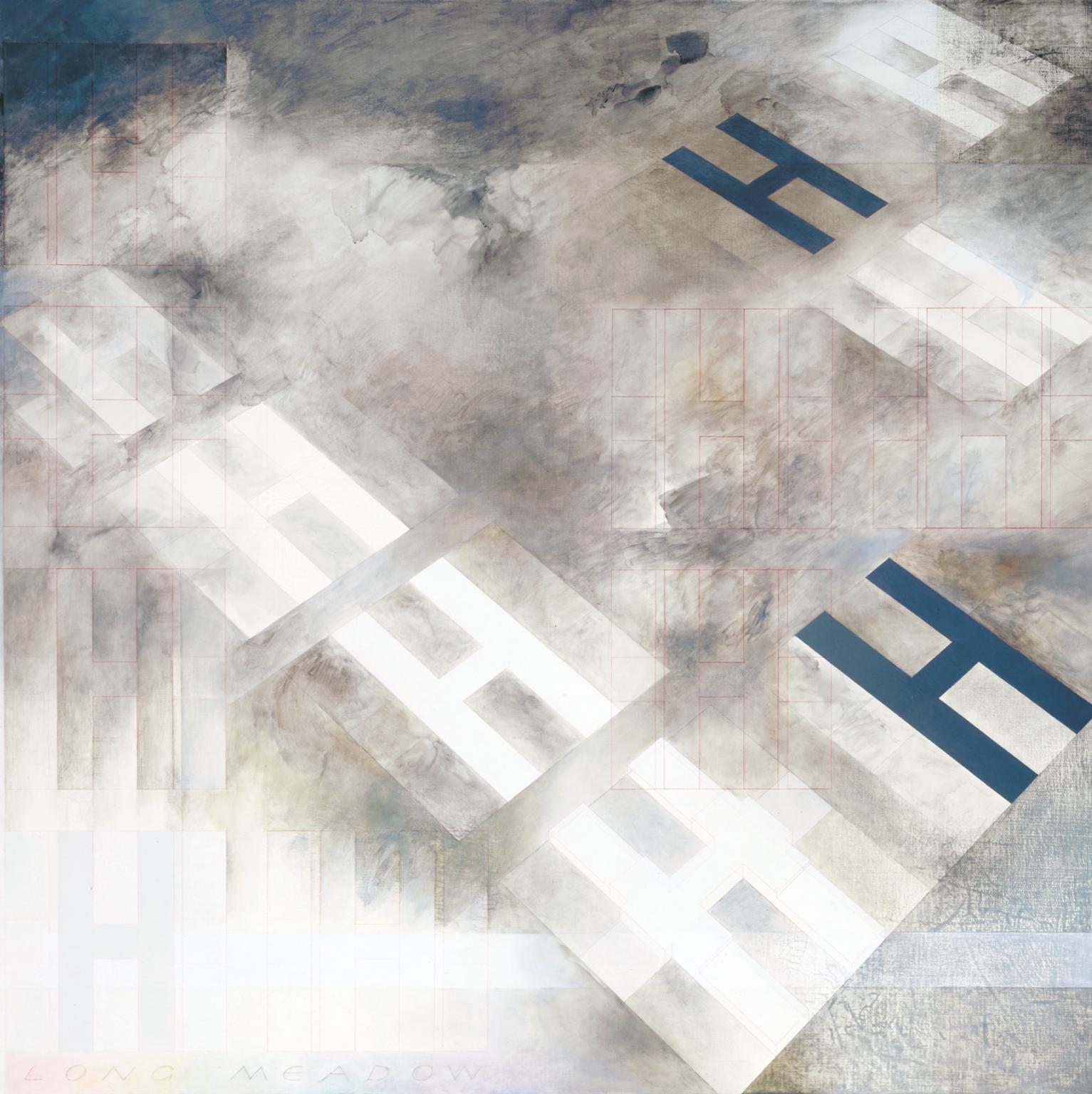
Rita Donagh, Long Meadow 1982
The conflict in the north of Ireland in the 1970s and 1980s saw violent acts by both Unionists and Republicans perpetrated in mainland Britain and Northern Ireland. One of the key sites during those times was the Maze Prison in County Antrim, formerly known as Long Kesh or ‘Long Meadow’, the title of Donagh’s painting. Paramilitary prisoners were housed in the eight prison ‘H Blocks’, projected by Donagh in perspective onto a square canvas, echoing the square plan of a single cell block. The aerial view and the subtle rendering of the light convey the feeling of an air raid.
Gallery label, September 2016
8/20
artworks in No Such Thing as Society
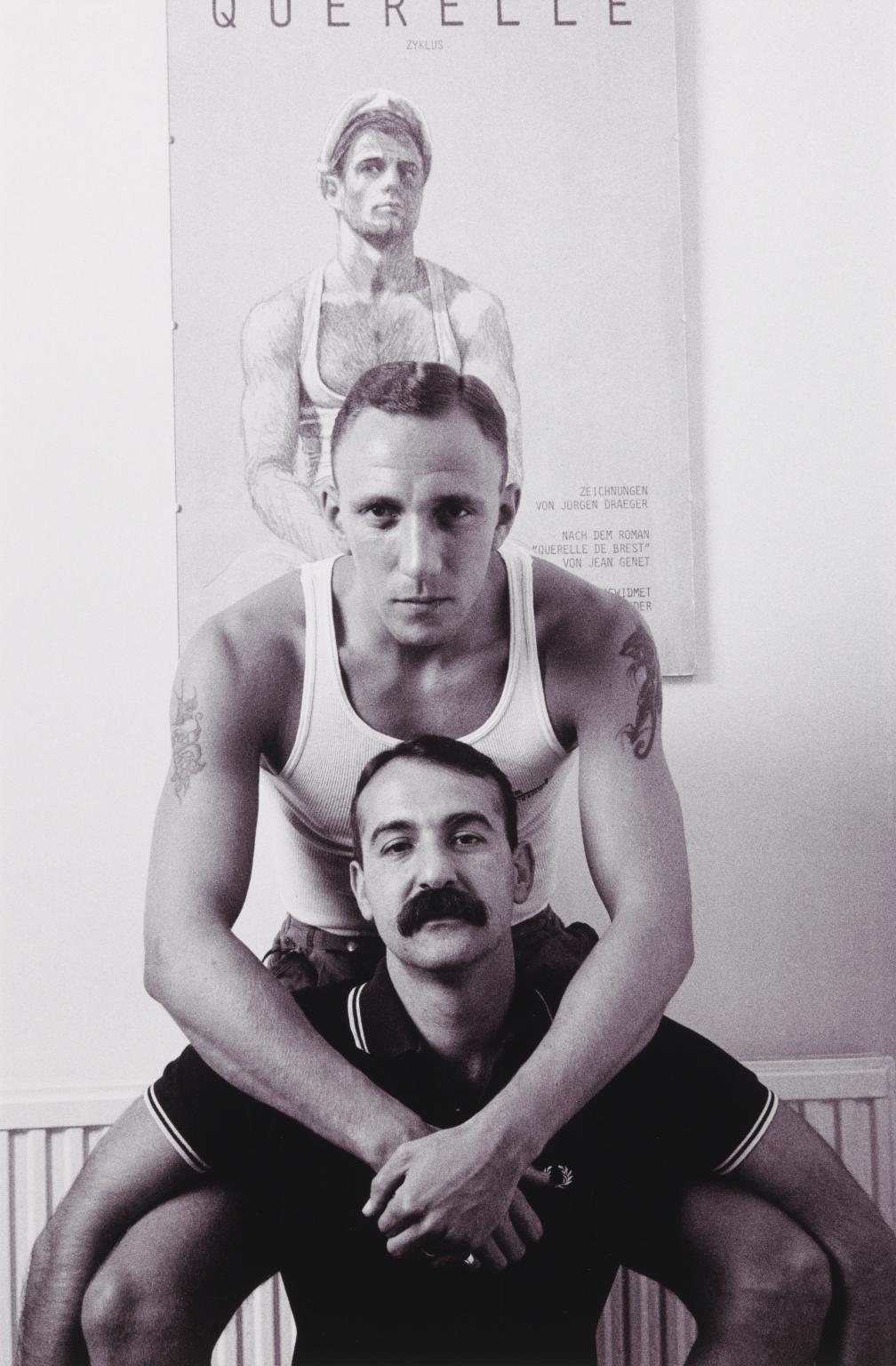
Sunil Gupta, Ian & Pavlik, London 1984, printed 2018
This is one of a group of photographs in Tate’s collection from Sunil Gupta’s Lovers: Ten Years On, a series of over thirty black and white portraits of gay couples taken in the United Kingdom between 1984 and 1986 (Tate P82123–P82137 and Ian and Julian P13784). With the exception of Martin & Gary, Newcastle-upon-Tyne 1984 (Tate P82123), they were all taken in London. Lovers: Ten Years On was made after Gupta’s own ten-year relationship ended and, as a form of social analysis, he decided to document the long-term gay relationships he encountered and the changing sensibilities of the social environment he found himself a part of. Most of the subjects are from his own social milieu at the time, professional couples resident in the Greater London area. Taken over a period of two years, the black and white portraits all follow the same format – they are shot in domestic interiors, the poses and arrangements reminiscent of traditional family photographs. The subjects are centred in the frame and look directly into the camera. Most of the couples are shown in affectionate poses and embraces within their domestic settings; some included their pets in the picture, others chose to be depicted in front of works of art in their living rooms, surrounded by books, or in their kitchens.The series was accompanied by an artist’s statement, in which Gupta observed that while there had been a shift in gay self-consciousness since the 1970s, the arrival of HIV and Aids had once again turned public opinion against the acceptance of homosexuality, and that its popular and commercial representations were dominated by a stereotype of deviance. In contrast, the couples in Lovers: Ten Years On are shown as often quite ordinary, white middle-class, professional people in long term monogamous relationships. Gupta wrote:
9/20
artworks in No Such Thing as Society

Sunil Gupta, Roger & Steve, London 1984, printed 2018
This is one of a group of photographs in Tate’s collection from Sunil Gupta’s Lovers: Ten Years On, a series of over thirty black and white portraits of gay couples taken in the United Kingdom between 1984 and 1986 (Tate P82123–P82137 and Ian and Julian P13784). With the exception of Martin & Gary, Newcastle-upon-Tyne 1984 (Tate P82123), they were all taken in London. Lovers: Ten Years On was made after Gupta’s own ten-year relationship ended and, as a form of social analysis, he decided to document the long-term gay relationships he encountered and the changing sensibilities of the social environment he found himself a part of. Most of the subjects are from his own social milieu at the time, professional couples resident in the Greater London area. Taken over a period of two years, the black and white portraits all follow the same format – they are shot in domestic interiors, the poses and arrangements reminiscent of traditional family photographs. The subjects are centred in the frame and look directly into the camera. Most of the couples are shown in affectionate poses and embraces within their domestic settings; some included their pets in the picture, others chose to be depicted in front of works of art in their living rooms, surrounded by books, or in their kitchens.The series was accompanied by an artist’s statement, in which Gupta observed that while there had been a shift in gay self-consciousness since the 1970s, the arrival of HIV and Aids had once again turned public opinion against the acceptance of homosexuality, and that its popular and commercial representations were dominated by a stereotype of deviance. In contrast, the couples in Lovers: Ten Years On are shown as often quite ordinary, white middle-class, professional people in long term monogamous relationships. Gupta wrote:
10/20
artworks in No Such Thing as Society
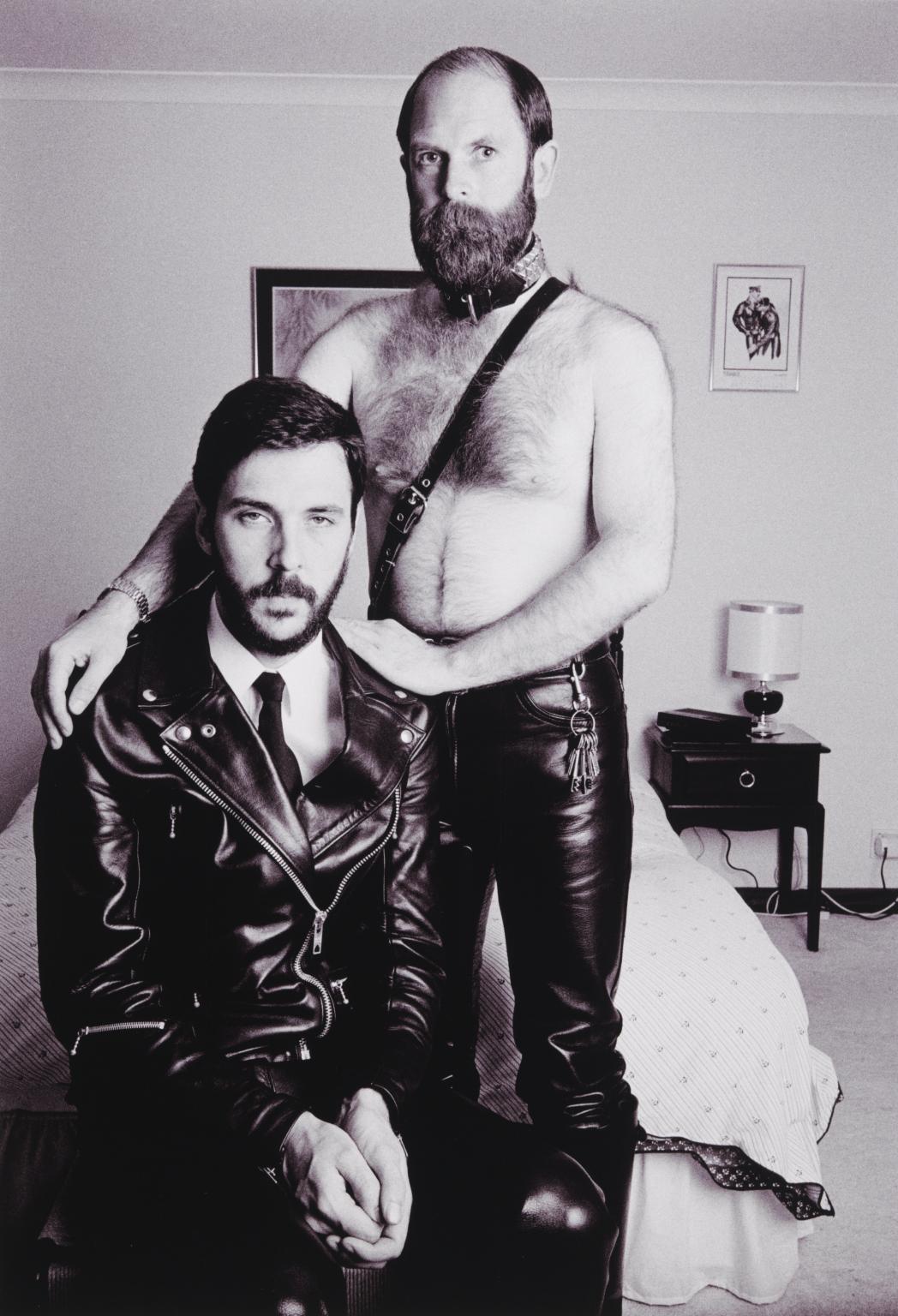
Sunil Gupta, Dylan & Gerald, London 1985, printed 2018
This is one of a group of photographs in Tate’s collection from Sunil Gupta’s Lovers: Ten Years On, a series of over thirty black and white portraits of gay couples taken in the United Kingdom between 1984 and 1986 (Tate P82123–P82137 and Ian and Julian P13784). With the exception of Martin & Gary, Newcastle-upon-Tyne 1984 (Tate P82123), they were all taken in London. Lovers: Ten Years On was made after Gupta’s own ten-year relationship ended and, as a form of social analysis, he decided to document the long-term gay relationships he encountered and the changing sensibilities of the social environment he found himself a part of. Most of the subjects are from his own social milieu at the time, professional couples resident in the Greater London area. Taken over a period of two years, the black and white portraits all follow the same format – they are shot in domestic interiors, the poses and arrangements reminiscent of traditional family photographs. The subjects are centred in the frame and look directly into the camera. Most of the couples are shown in affectionate poses and embraces within their domestic settings; some included their pets in the picture, others chose to be depicted in front of works of art in their living rooms, surrounded by books, or in their kitchens.The series was accompanied by an artist’s statement, in which Gupta observed that while there had been a shift in gay self-consciousness since the 1970s, the arrival of HIV and Aids had once again turned public opinion against the acceptance of homosexuality, and that its popular and commercial representations were dominated by a stereotype of deviance. In contrast, the couples in Lovers: Ten Years On are shown as often quite ordinary, white middle-class, professional people in long term monogamous relationships. Gupta wrote:
11/20
artworks in No Such Thing as Society
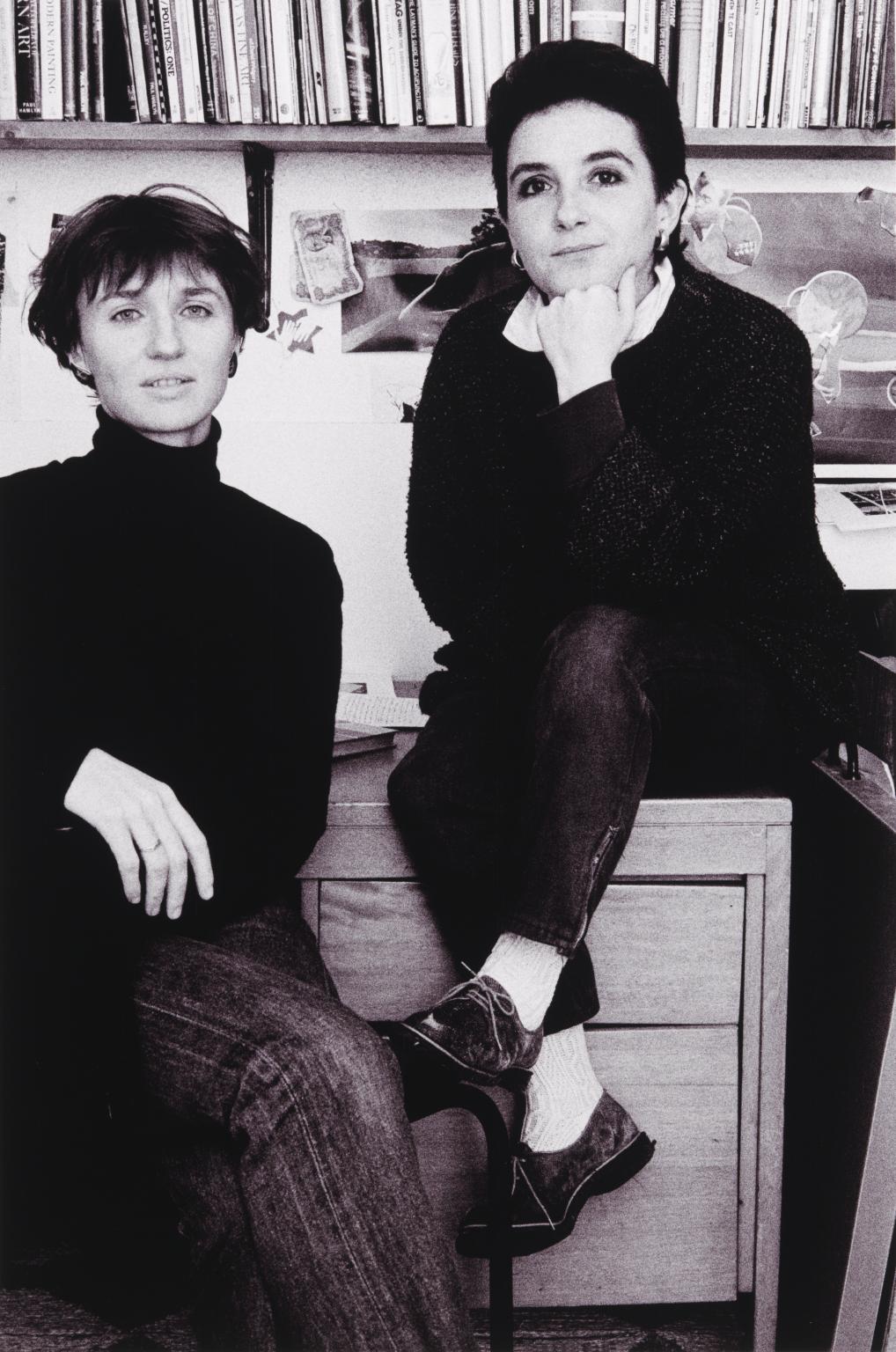
Sunil Gupta, Sue & Yve, London 1984, printed 2018
This is one of a group of photographs in Tate’s collection from Sunil Gupta’s Lovers: Ten Years On, a series of over thirty black and white portraits of gay couples taken in the United Kingdom between 1984 and 1986 (Tate P82123–P82137 and Ian and Julian P13784). With the exception of Martin & Gary, Newcastle-upon-Tyne 1984 (Tate P82123), they were all taken in London. Lovers: Ten Years On was made after Gupta’s own ten-year relationship ended and, as a form of social analysis, he decided to document the long-term gay relationships he encountered and the changing sensibilities of the social environment he found himself a part of. Most of the subjects are from his own social milieu at the time, professional couples resident in the Greater London area. Taken over a period of two years, the black and white portraits all follow the same format – they are shot in domestic interiors, the poses and arrangements reminiscent of traditional family photographs. The subjects are centred in the frame and look directly into the camera. Most of the couples are shown in affectionate poses and embraces within their domestic settings; some included their pets in the picture, others chose to be depicted in front of works of art in their living rooms, surrounded by books, or in their kitchens.The series was accompanied by an artist’s statement, in which Gupta observed that while there had been a shift in gay self-consciousness since the 1970s, the arrival of HIV and Aids had once again turned public opinion against the acceptance of homosexuality, and that its popular and commercial representations were dominated by a stereotype of deviance. In contrast, the couples in Lovers: Ten Years On are shown as often quite ordinary, white middle-class, professional people in long term monogamous relationships. Gupta wrote:
12/20
artworks in No Such Thing as Society
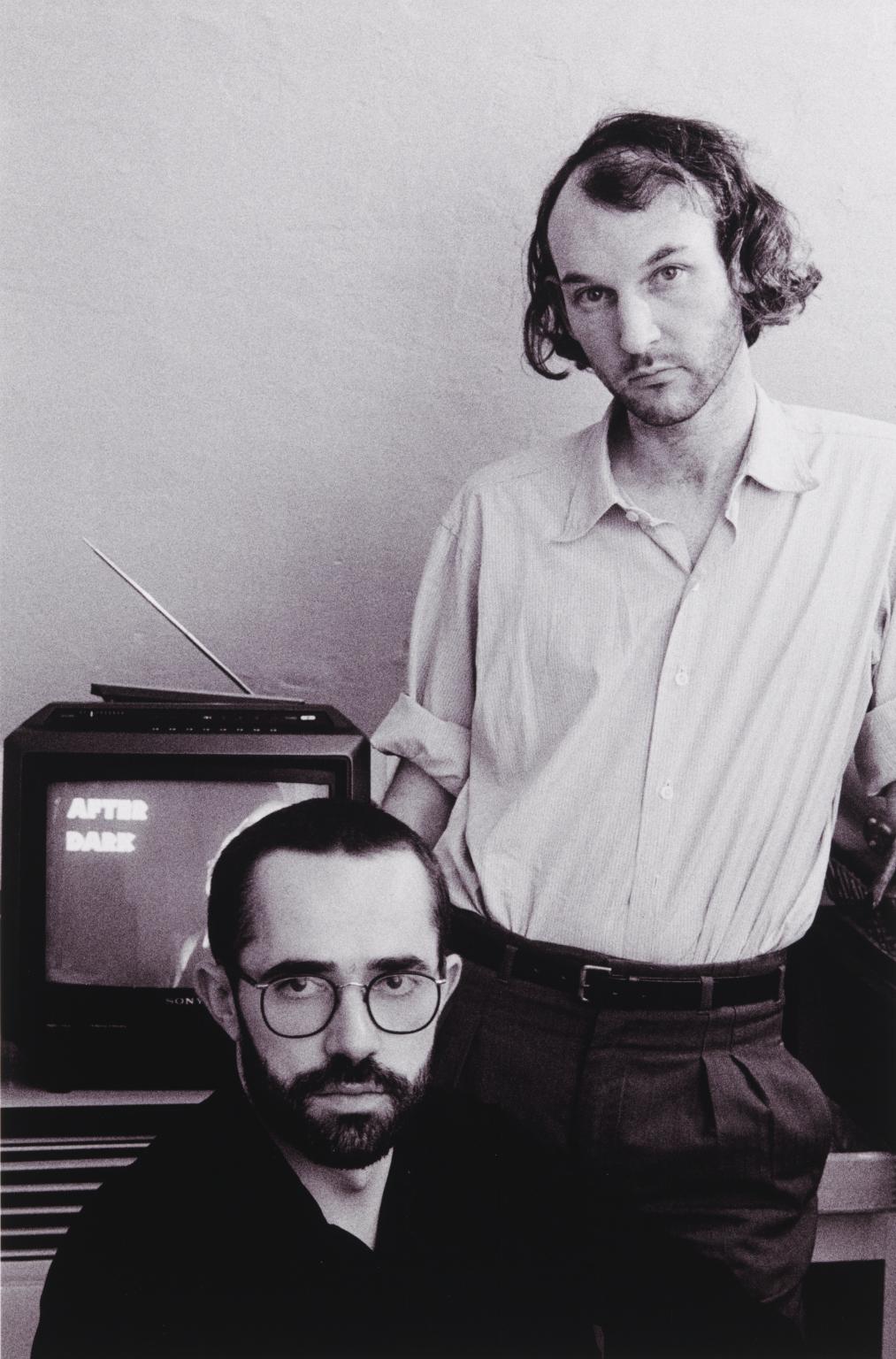
Sunil Gupta, Guy & Brian, London 1984, printed 2018
This is one of a group of photographs in Tate’s collection from Sunil Gupta’s Lovers: Ten Years On, a series of over thirty black and white portraits of gay couples taken in the United Kingdom between 1984 and 1986 (Tate P82123–P82137 and Ian and Julian P13784). With the exception of Martin & Gary, Newcastle-upon-Tyne 1984 (Tate P82123), they were all taken in London. Lovers: Ten Years On was made after Gupta’s own ten-year relationship ended and, as a form of social analysis, he decided to document the long-term gay relationships he encountered and the changing sensibilities of the social environment he found himself a part of. Most of the subjects are from his own social milieu at the time, professional couples resident in the Greater London area. Taken over a period of two years, the black and white portraits all follow the same format – they are shot in domestic interiors, the poses and arrangements reminiscent of traditional family photographs. The subjects are centred in the frame and look directly into the camera. Most of the couples are shown in affectionate poses and embraces within their domestic settings; some included their pets in the picture, others chose to be depicted in front of works of art in their living rooms, surrounded by books, or in their kitchens.The series was accompanied by an artist’s statement, in which Gupta observed that while there had been a shift in gay self-consciousness since the 1970s, the arrival of HIV and Aids had once again turned public opinion against the acceptance of homosexuality, and that its popular and commercial representations were dominated by a stereotype of deviance. In contrast, the couples in Lovers: Ten Years On are shown as often quite ordinary, white middle-class, professional people in long term monogamous relationships. Gupta wrote:
13/20
artworks in No Such Thing as Society
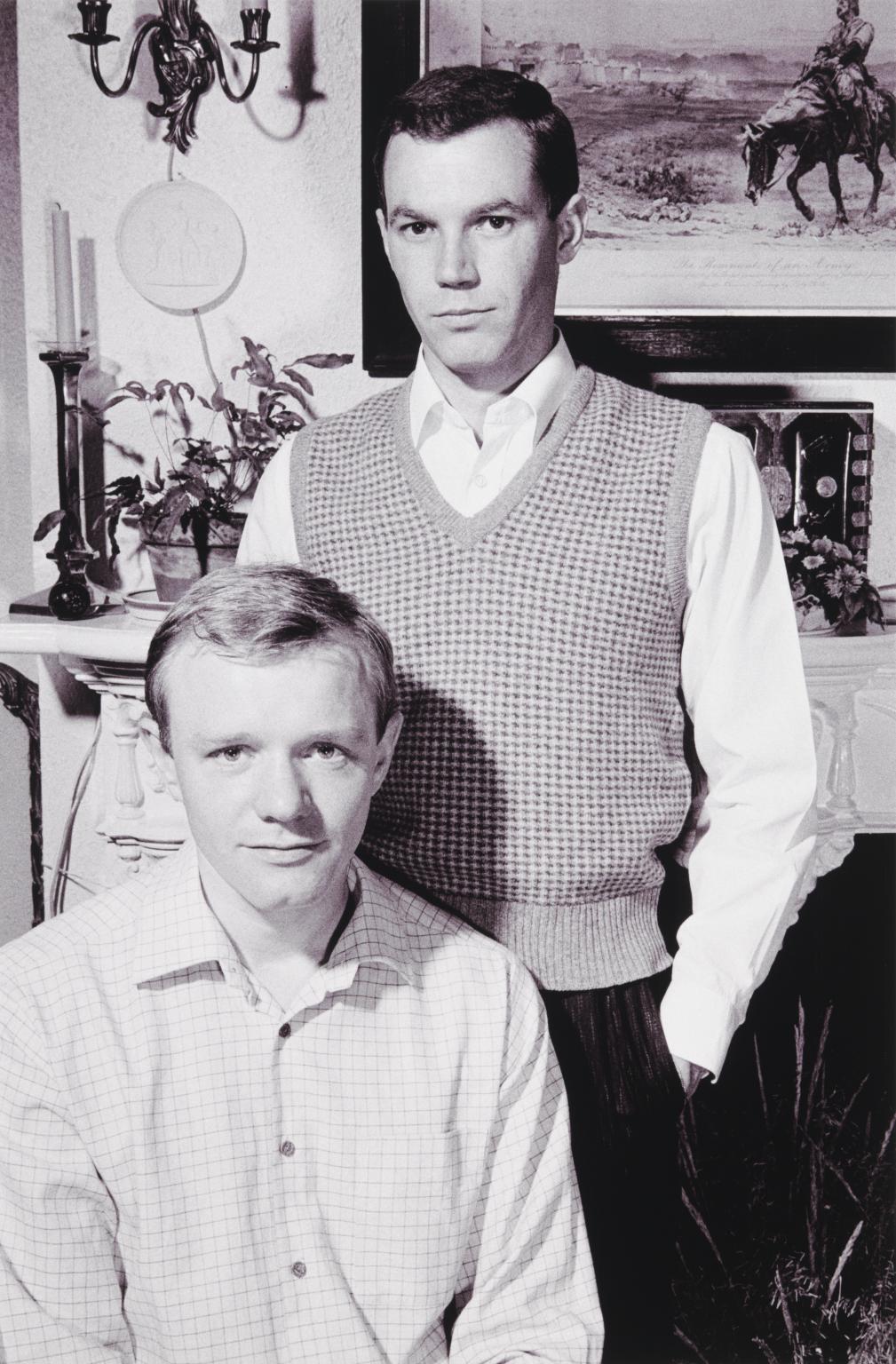
Sunil Gupta, Karl & Daniel, London 1985, printed 2018
This is one of a group of photographs in Tate’s collection from Sunil Gupta’s Lovers: Ten Years On, a series of over thirty black and white portraits of gay couples taken in the United Kingdom between 1984 and 1986 (Tate P82123–P82137 and Ian and Julian P13784). With the exception of Martin & Gary, Newcastle-upon-Tyne 1984 (Tate P82123), they were all taken in London. Lovers: Ten Years On was made after Gupta’s own ten-year relationship ended and, as a form of social analysis, he decided to document the long-term gay relationships he encountered and the changing sensibilities of the social environment he found himself a part of. Most of the subjects are from his own social milieu at the time, professional couples resident in the Greater London area. Taken over a period of two years, the black and white portraits all follow the same format – they are shot in domestic interiors, the poses and arrangements reminiscent of traditional family photographs. The subjects are centred in the frame and look directly into the camera. Most of the couples are shown in affectionate poses and embraces within their domestic settings; some included their pets in the picture, others chose to be depicted in front of works of art in their living rooms, surrounded by books, or in their kitchens.The series was accompanied by an artist’s statement, in which Gupta observed that while there had been a shift in gay self-consciousness since the 1970s, the arrival of HIV and Aids had once again turned public opinion against the acceptance of homosexuality, and that its popular and commercial representations were dominated by a stereotype of deviance. In contrast, the couples in Lovers: Ten Years On are shown as often quite ordinary, white middle-class, professional people in long term monogamous relationships. Gupta wrote:
14/20
artworks in No Such Thing as Society
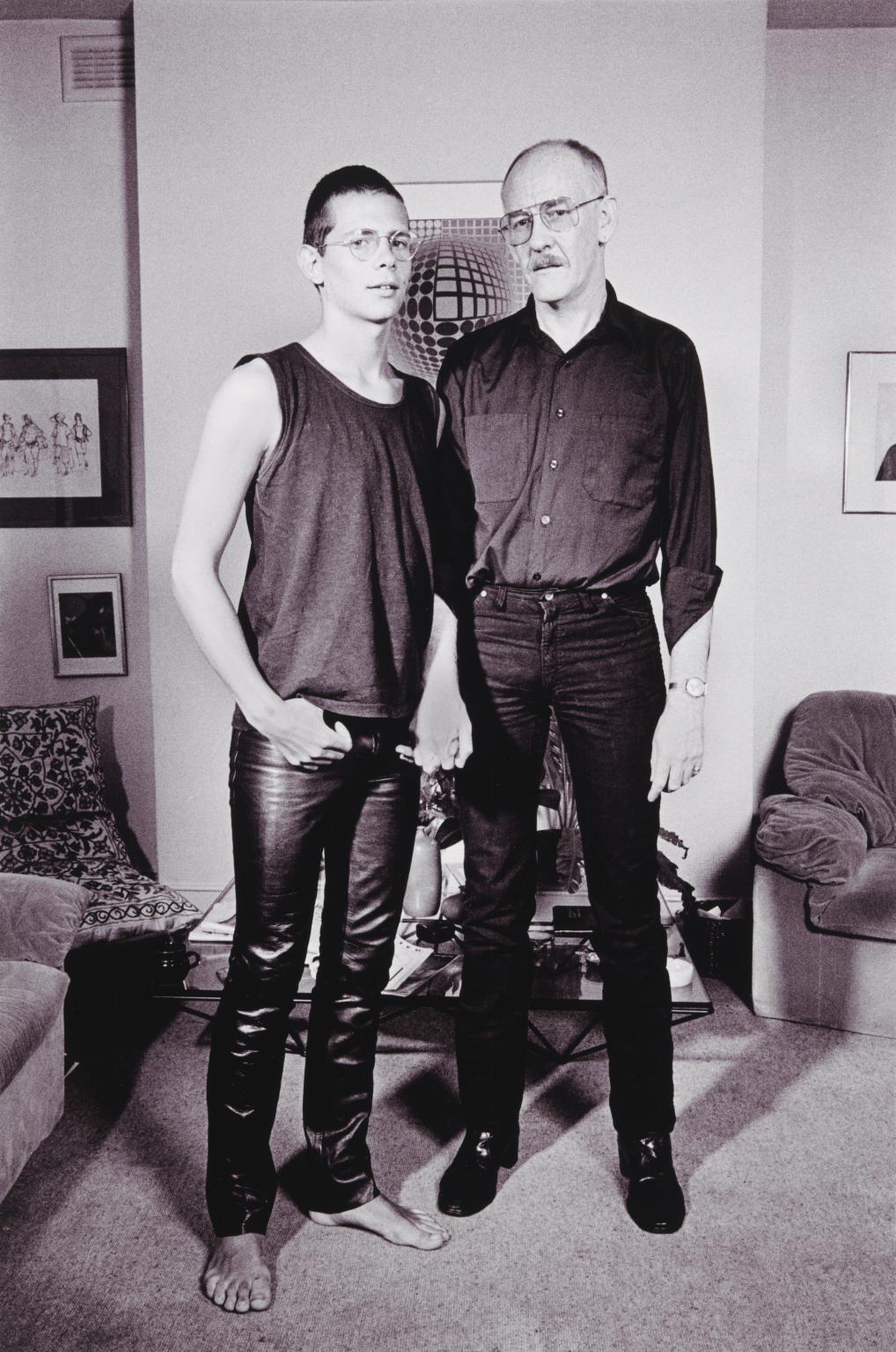
Sunil Gupta, Andrew & John, London 1985, printed 2018
This is one of a group of photographs in Tate’s collection from Sunil Gupta’s Lovers: Ten Years On, a series of over thirty black and white portraits of gay couples taken in the United Kingdom between 1984 and 1986 (Tate P82123–P82137 and Ian and Julian P13784). With the exception of Martin & Gary, Newcastle-upon-Tyne 1984 (Tate P82123), they were all taken in London. Lovers: Ten Years On was made after Gupta’s own ten-year relationship ended and, as a form of social analysis, he decided to document the long-term gay relationships he encountered and the changing sensibilities of the social environment he found himself a part of. Most of the subjects are from his own social milieu at the time, professional couples resident in the Greater London area. Taken over a period of two years, the black and white portraits all follow the same format – they are shot in domestic interiors, the poses and arrangements reminiscent of traditional family photographs. The subjects are centred in the frame and look directly into the camera. Most of the couples are shown in affectionate poses and embraces within their domestic settings; some included their pets in the picture, others chose to be depicted in front of works of art in their living rooms, surrounded by books, or in their kitchens.The series was accompanied by an artist’s statement, in which Gupta observed that while there had been a shift in gay self-consciousness since the 1970s, the arrival of HIV and Aids had once again turned public opinion against the acceptance of homosexuality, and that its popular and commercial representations were dominated by a stereotype of deviance. In contrast, the couples in Lovers: Ten Years On are shown as often quite ordinary, white middle-class, professional people in long term monogamous relationships. Gupta wrote:
15/20
artworks in No Such Thing as Society
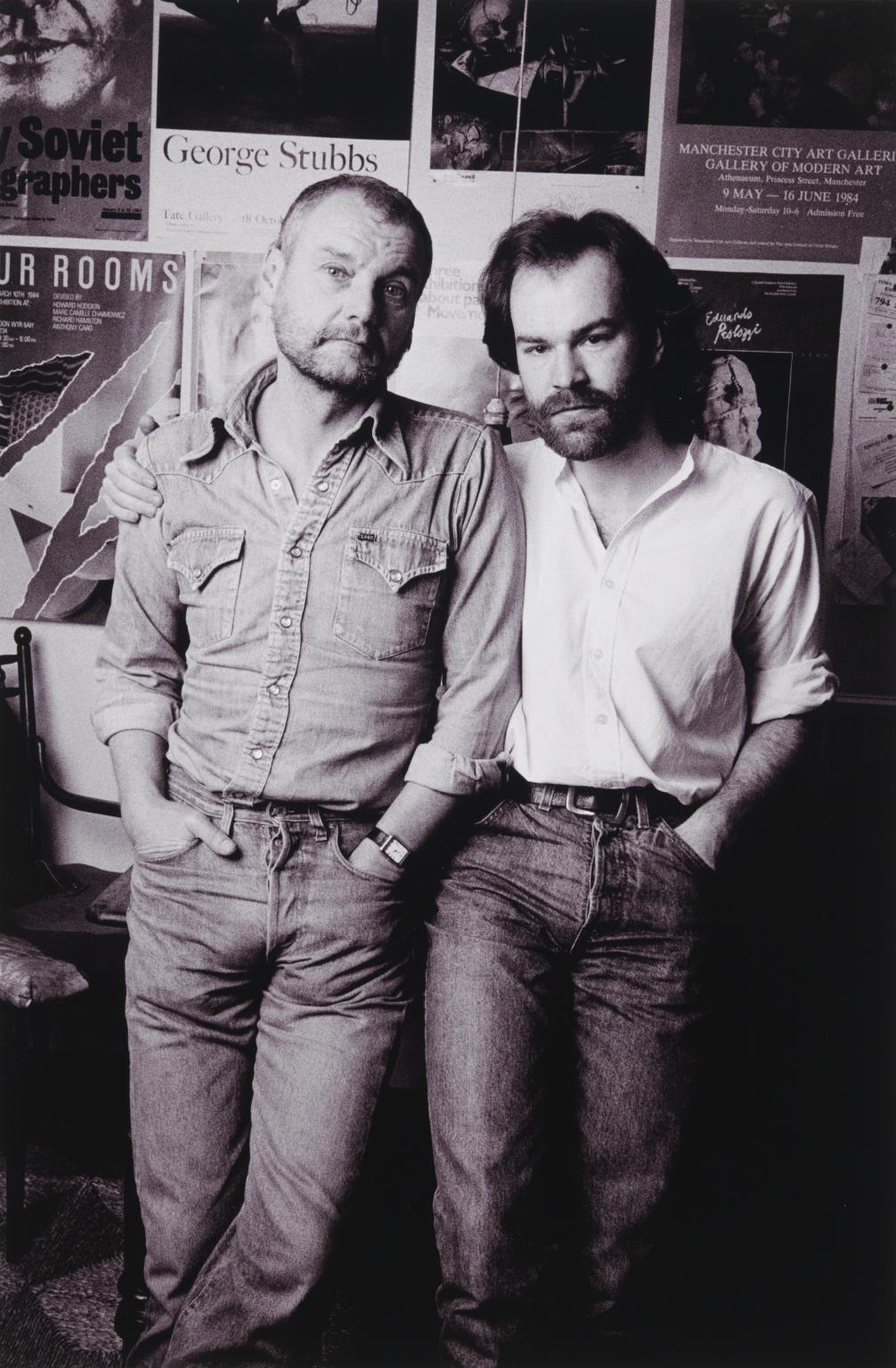
Sunil Gupta, Emmanuel & David, London 1984, printed 2018
This is one of a group of photographs in Tate’s collection from Sunil Gupta’s Lovers: Ten Years On, a series of over thirty black and white portraits of gay couples taken in the United Kingdom between 1984 and 1986 (Tate P82123–P82137 and Ian and Julian P13784). With the exception of Martin & Gary, Newcastle-upon-Tyne 1984 (Tate P82123), they were all taken in London. Lovers: Ten Years On was made after Gupta’s own ten-year relationship ended and, as a form of social analysis, he decided to document the long-term gay relationships he encountered and the changing sensibilities of the social environment he found himself a part of. Most of the subjects are from his own social milieu at the time, professional couples resident in the Greater London area. Taken over a period of two years, the black and white portraits all follow the same format – they are shot in domestic interiors, the poses and arrangements reminiscent of traditional family photographs. The subjects are centred in the frame and look directly into the camera. Most of the couples are shown in affectionate poses and embraces within their domestic settings; some included their pets in the picture, others chose to be depicted in front of works of art in their living rooms, surrounded by books, or in their kitchens.The series was accompanied by an artist’s statement, in which Gupta observed that while there had been a shift in gay self-consciousness since the 1970s, the arrival of HIV and Aids had once again turned public opinion against the acceptance of homosexuality, and that its popular and commercial representations were dominated by a stereotype of deviance. In contrast, the couples in Lovers: Ten Years On are shown as often quite ordinary, white middle-class, professional people in long term monogamous relationships. Gupta wrote:
16/20
artworks in No Such Thing as Society
Veronica Slater, Soul Identified as Flesh 1987 – 1988
17/20
artworks in No Such Thing as Society
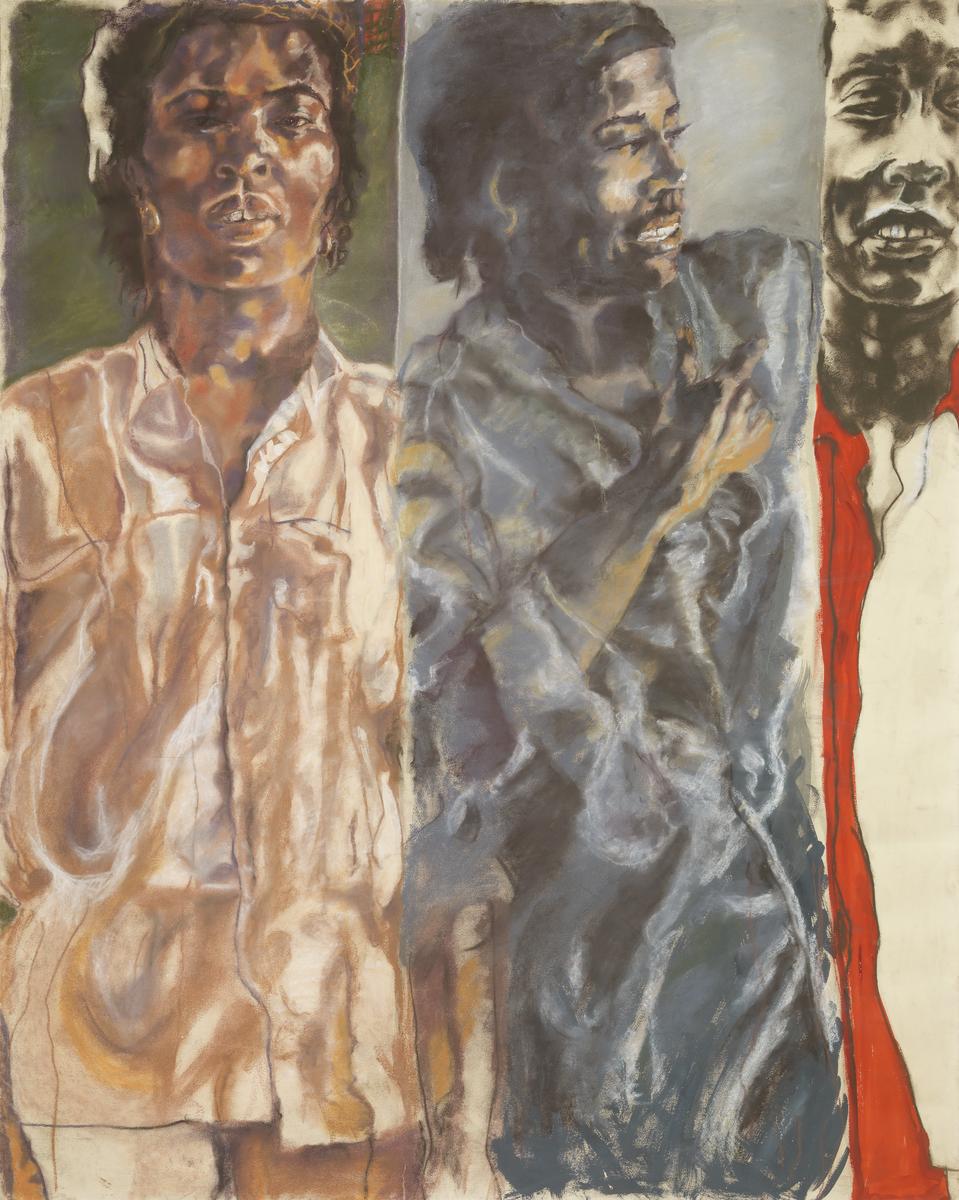
Claudette Johnson MBE, Untitled 1987
Untitled depicts different views of the same woman, artist Brenda Agard (1961–2012). Agard and Johnson exhibited together in the 1980s. They were both included in The Thin Black Line, the landmark exhibition curated by artist Lubaina Himid (born 1954) at the Institute of Contemporary Arts, London in 1985. Johnson is known for her larger-than-life drawings of Black women. Her figures seem to resist their containment within the paper on which she works. She describes her work as existing outside the realm of portraiture. Johnson instead creates a ‘presence’ for her subjects, that resists objectification.
Gallery label, December 2020
18/20
artworks in No Such Thing as Society
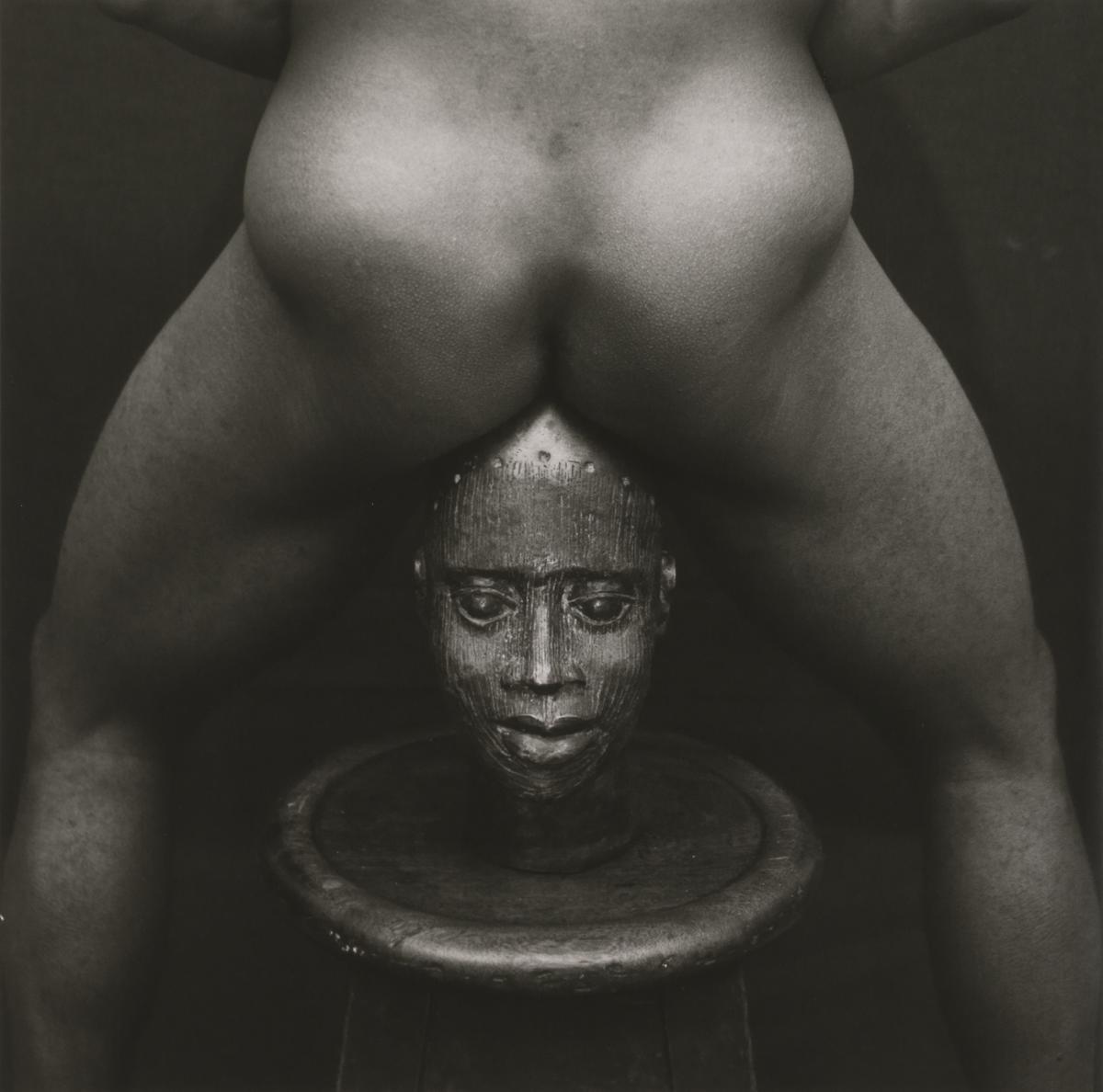
Rotimi Fani-Kayode, Bronze Head 1987, printed c.1987–8
Nigerian-born Fani-Kayode moved to Brighton at the age of 12 to escape civil war. His photographs explore issues of racial, sexual and cultural identity – Bronze Head shows a man’s buttocks and legs above the head of a Yoruba god. Fani-Kayode said his identity came from his own sense of otherness: ‘It is photography therefore – Black, African, homosexual photography – which I must use not just as an instrument, but as a weapon if I am to resist attacks on my integrity and, indeed, my existence on my own terms.’ In 1987 he co-founded Autograph ABP (Association of Black Photographers).
Gallery label, September 2018
19/20
artworks in No Such Thing as Society
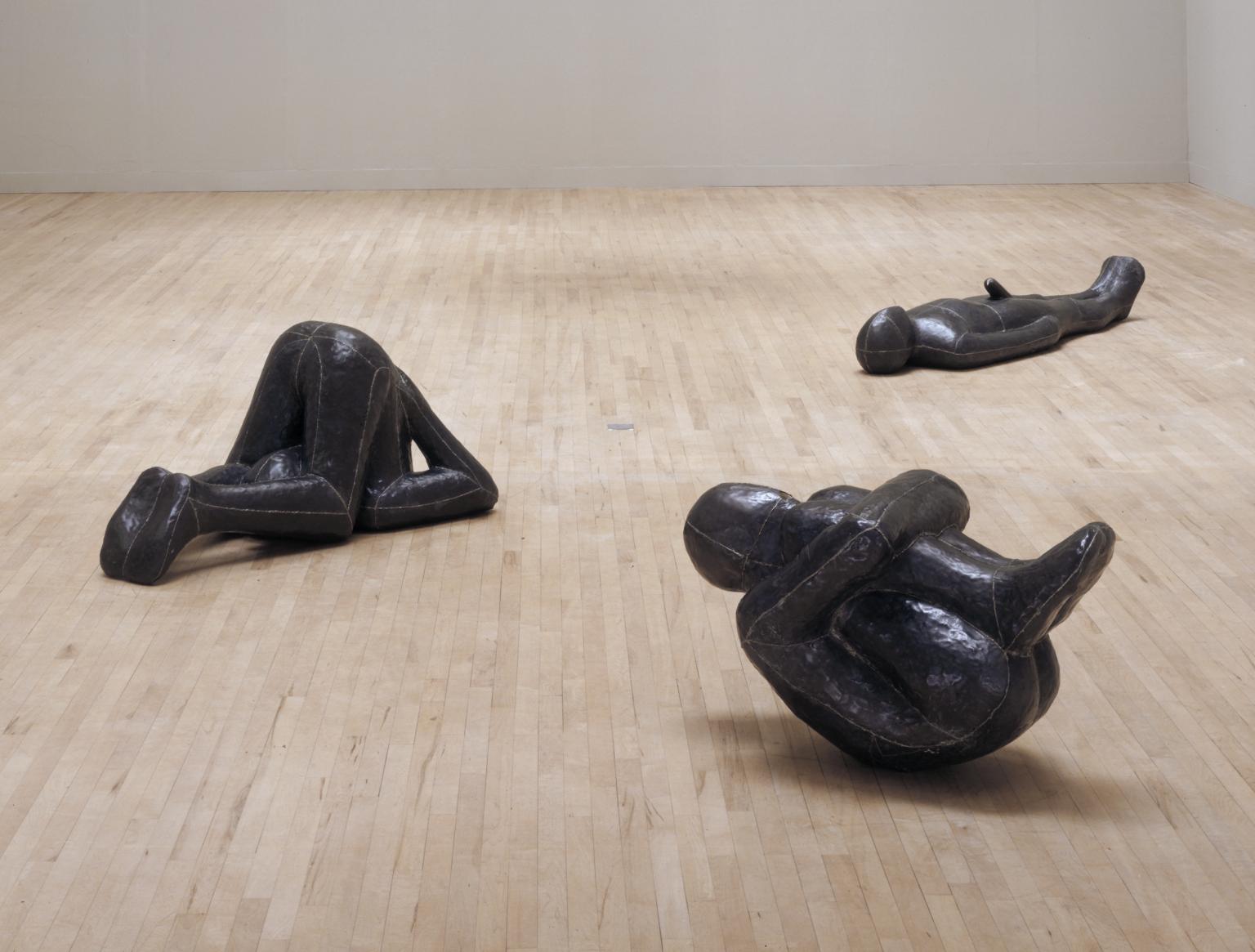
Sir Antony Gormley OBE RA, Three Ways: Mould Hole and Passage 1981–2
'You are aware that there is a transition, that something that is happening within you is gradually registering externally.' This is how Antony Gormley described his experience of making plaster casts of his own body. For Three Ways he used such casts to make lead figures in three simple poses: curled into a ball, bending over and lying down.
The sculptures have holes at the mouth, anus and penis respectively. These break the seemingly impenetrable surface of the lead body cases, suggesting an interaction between the outside world and the hollow space enclosed within.
Gallery label, August 2004
20/20
artworks in No Such Thing as Society
Art in this room
















Sorry, no image available



You've viewed 6/20 artworks
You've viewed 20/20 artworks
